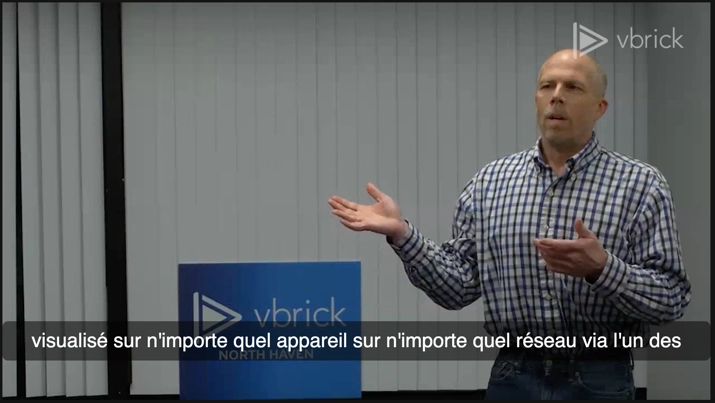4 Considerations for Using Video AI
Share on Social
Video has become a staple of virtually every meeting in the Enterprise. Sales & Marketing teams have discovered how powerful video is for driving conversion rates. And the majority of chief executives are using video to deliver town hall meetings to drive strategic alignment, employee engagement and overall organizational performance.

The challenge of shifting to video for communication is that it’s becoming impossible to catalog every single piece of new content that’s being created. That makes it challenging to find the information stored in those videos. Employees can’t waste time watching hundreds or thousands of hours of video to find the information they need.
Video AI such as machine transcription, translation and user tagging when combined with advanced search and recommendations can help to bridge this gap. Then employees can search across your entire collection of videos
to find the exact moment in the right video to get the information that they need. Adding subtitles in multiple languages not only makes content more accessible, but also more inclusive for employees to watch in their preferred language.
However, as any company who has tried to use machine transcription for high profile content like a CEO town hall or marketing email knows, the technology isn’t perfect. Most organizations have their own brand names, departmental lingo, acronyms and even people’s names that are important to get right.
Bridging the Quality Gap with Video AI
Using raw machine transcription for company-wide webcasts can be a non-starter. Every company uses brand names and other terms that transcription engines won’t know out of the box. In some cases, the results it provides can be confusing or even downright embarrassing. Fortunately, there are a few things you can do to help bridge the gap.
We’re launching two features that can help:
The first one is to create a custom dictionary using our Vbrick Rev IQ video AI solution that lets you add words specific to your organization to help train the transcription. Not every platform offers this capability, but it can go a long way to improving transcription accuracy. You will want to include the company name, major brands, departments and acronyms. It’s also good to add the names of speakers or important executives.
These custom dictionaries won’t get you to 100% accuracy but they will definitely get you to a place where you can quickly clean up any remaining corrections in post-production. That’s another functionality we recently added to Rev; you can now ‘quick edit’ subtitles in any language so you can have confidence that they’re correct without having to manually transcribe your content.
Building an Enrichment Strategy
 Once you have the tools you need for providing high quality subtitles, it’s time to evaluate your other enrichment needs. It’s important to consider different types of content and what additional metadata you want to add. Some content might already be transcribed, like a meeting recording, but you may want to translate the subtitles into additional languages or tag users in the video.
Once you have the tools you need for providing high quality subtitles, it’s time to evaluate your other enrichment needs. It’s important to consider different types of content and what additional metadata you want to add. Some content might already be transcribed, like a meeting recording, but you may want to translate the subtitles into additional languages or tag users in the video.
Some other examples include, if you want to provide all hands or company announcements in multiple languages in order to support international employees. Or you could have technical videos that are only used by employees in one language that you want to transcribe and make searchable. Or you may want to provide marketing content in more than one language depending on what markets you serve.
Note that if you want to tag users in your video content, you need to have high quality photos to use as a reference, and importantly, you also need to make sure you have permission to use those photos. The Rev platform easily allows any employee to opt out of using their photo for facial recognition.
Lastly, get a sense for how much content you’re creating and whether you have existing content that you want to enrich with video AI. Once you have this inventory completed, you may find that the sheer volume of content you want to enrich could force you to prioritize where you want to start.
Cost-Sharing Model
Depending on how much content you have and your goals for using video enrichment AI, it might not have been planned into your existing budget. This could mean prioritizing the most valuable use cases and enriching your content over time. Or you may be able to find ways to share these costs with other teams within your organization.
For this reason, we can provide reporting on which users are enriching their content and what the relative costs are. That way you can build a chargeback model so that the other teams can fund their own video enrichment AI needs if they are interested.
Driving Discoverability with Video AI
Now that you have added all of this rich metadata to your video content, you can surface it to employees to help accelerate their work.You will want to consider who can contribute content and what content your individual teams should be able to access.
Vbrick Rev provides comprehensive search capabilities as well as role-based access control and individual level permissions that help make content easily discoverable. We also provide content recommendations that help surface content that is popular, timely and is related to each individual user’s interests.
Wrap Up
As the ease of video content creation continues to accelerate, it will increasingly become a valuable tool for capturing knowledge from across your enterprise. The key is to have an Enterprise–wide strategy for managing that video content, and the right tools to surface that content to help accelerate learning and knowledge sharing between employees across departments, and around the globe.




